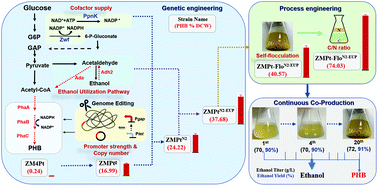Metabolic engineering of Zymomonas mobilis for continuous co-production of bioethanol and poly-3-hydroxybutyrate (PHB)†
Abstract
Zymomonas mobilis is a native ethanologen with the unique anaerobic Entner Doudoroff pathway. In this study, a heterologous poly-3-hydroxybutyrate (PHB) pathway was engineered into Z. mobilis. Genetic strategies were applied to improve PHB production including overexpression of the phaCAB operon by using a strong promoter and/or increasing its copy numbers, cofactor balance by overexpressing the endogenous genes for NADPH balance, and competition of acetaldehyde for acetyl-CoA generation through the ethanol utilization pathway (EUP). PHB contents in recombinant strains were enhanced gradually. The highest PHB content of 37.68 ± 2.56% (dry cell weight, DCW) was achieved in the ZMPtN2-EUP strain, which contains copies of the phaCAB operon in both the chromosome and plasmid, an extra copy of the native zwf gene for cofactor balance, and genes for the EUP. The PHB production in ZMPtN2-EUP was further improved by optimizing the C/N ratio, and the PHB content was increased to 50.30 ± 3.39% (DCW) at a C/N ratio of 20/2 (20 g L−1 glucose and 2 g L−1 yeast extract). ZMPtN2-EUP was then empowered with the self-flocculating phenotype using a native CRISPR-Cas genome editing system to generate ZMPt-FloN2-EUP for biomass recovery through gravity sedimentation. The PHB content of 40.57 ± 0.60% (DCW) in ZMPt-FloN2-EUP with self-flocculation capability was slightly higher than that of ZMPtN2-EUP, which further increased to 74.03 ± 1.81% (DCW) at a C/N ratio of 20/2. Moreover, ZMPtN2-EUP was able to be used as a microbial biocatalyst for continuous co-production of high-titer ethanol and PHB without affecting ethanol percentage productivity. Our study thus demonstrated that the strategy to combine genetic and process engineering is effective to develop non-model microorganisms for heterologous production of bio-based chemicals, and the capability of Z. mobilis for continuous co-production of high-titer ethanol and PHB exhibited that Z. mobilis is a promising chassis for economic biochemical production.



 Please wait while we load your content...
Please wait while we load your content...